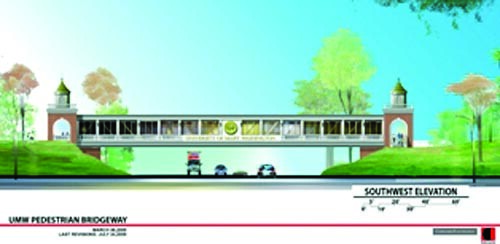A Pedestrian Bridge to Cross Over Route 1
3 min read
By AMBER GOLDWASSER
In order to complete the Eagle Village pedestrian bridge, the UMW Foundation had to get permission from the City of Fredericksburg.
The bridge will be built over U.S. 1 to connect Eagle Village to the main campus. The construction of the steel frame will be completed in mid-January, at which point work on the interior and exterior of the bridge will begin, according to Jeff Rountree, chief executive officer of the UMW Foundation.
In order to complete the bridge, the school will use three cranes to install the walkway’s prebuilt pieces, according to the Free Lance-Star.
Rountree said the minimum height for the bridge, as measured from the roadway to the bottom of the bridge, is 13 feet as required by the Virginia Department of Transportation.
The Eagle Village bridge, however, will be nearly 18 feet above U.S. 1, which is far more than required, according to Rountree.
In order to obtain full approval for the bridge, UMW had to buy an air rights deal from the city.
“That space extends presumably to the Moon, or some other planet in that vicinity,” Rountree joked.
“This is a clear span bridge, which means there are no concrete pillars in the middle of the highway supporting the structure, which makes the Eagle Village bridge a complex and challenging engineering feat,” he said.
He said the bridge will consist of three 64-foot sections.
“The current plan is to lift the three pieces of the 192-foot bridge span into place sometime in January,” Rountree said.
“The bridge will be a steel structure internally with brick, glass and columns on the exterior,” Rountree said. This bridge will also be enclosed and will have a roof, according to the University of Mary Washington website.
The Foundation made this choice while anticipating that U.S. 1 may be widened in the future.
“The bridge is designed to span eight lanes of traffic, plus two additional turning lanes,” Rountree said. “[It] is designed to be an extension of campus walk, with easy access from both sides and no steps…[an] all brick pathway with a gentle slope.”
The bridge will be 14 feet wide and will be able to accommodate people, bicycles, and electric maintenance carts and police carts. However, no benches will be placed on the bridge.
Currently the project for the Eagle Village and the bridge are on schedule, Rountree said.
“The bridge will open when the premium student housing complex is open, which will be in August 2010,” Rountree said.
Currently the bridge is unnamed, but will have the university name and seal on either side, according to Rountree. The estimated cost is around $3.5 million.
The Foundation has financed this addition separately from the university.
“Everything you see at Eagle Village, including the bridge, is being privately developed by the UMW Foundation, not the university,” Rountree said. “Absolutely no student fees or state university funding is being used for anything over there.”
Rountree anticipates that students will use this bridge, since he said it will be the easiest, shortest and safest way to cross U.S. 1 from the village.
“I’m excited about the new bridge. This way, I can cross the street without worrying about getting hit by a car,” junior Colleen Trachy said.


